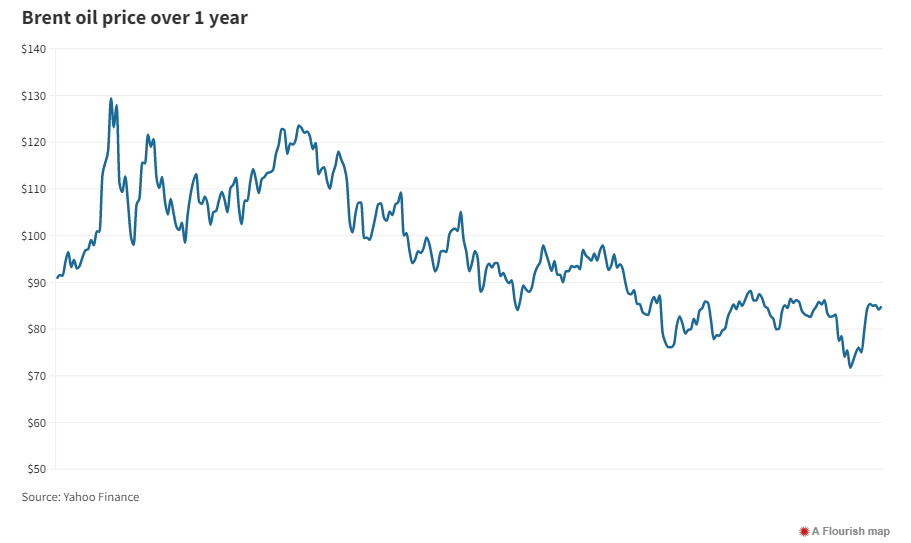Drop in crude inventories and supply disruption from northern Iraq of almost 500,000 barrel per day also a factor

An oil field in Russia, which said the 500,000 bpd cut it was implementing from March to June would continue until the end of the year. Bloomberg
The voluntary production cuts by some members of the Opec+ group of crude producers should tighten the oil market further from May onwards and boost prices, Swiss lender UBS has said.
A drop in crude inventories and supply disruption from northern Iraq of almost 500,000 barrels per day are also supporting prices that could rally towards the $100 mark, UBS said in its latest oil market report on Tuesday.
“While flows may resume [from Iraq] in the short term, the interruption and the upcoming voluntary production cuts by nine oil producers should help tighten the oil market further,” UBS said in report co-authored by its strategists Giovanni Staunovo, Wayne Gordon and Dominic Schnider.
“As a result, we continue to expect oil prices to recover towards $100 per barrel over the coming quarters.”
Opec+ members including Saudi Arabia, the UAE, Iraq, Kuwait, Oman and Algeria on April 2 surprised the market and said they would introduce combined voluntary oil production cuts of 1.16 million barrels per day from May until the end of this year.
Saudi Arabia, the world’s biggest oil exporter and Opec's largest producer, will cut its output by 500,000 bpd from May until the end of the year, while the UAE will cut its output by 144,000 bpd for the same period.

Russia, which is part of the 23-member Opec+ group, said the 500,000 bpd cut it was implementing from March to June would continue until the end of the year.
The producers said the precautionary measure was aimed at supporting the stability of the oil market.
The latest pledge of cuts by Opec+, which slashed its collective output by two million barrels per day in October last year, has pushed the volume of the group’s production caps to about 3.6 million bpd, about 3.6 per cent of Opec’s 101.9 million bpd estimated world oil demand this year.
Goldman Sachs, which had reduced its oil price forecast for 2023 on growing supplies and lower demand, now expects Brent to trade at $95 a barrel by the end of this year from a previous $90 estimate, and $100 in 2024 compared with a prior $97 forecast.
The investment bank expects a nearly 90 per cent implementation rate for the 1.16 million bpd combined cut, as the countries that announced them “have a strong compliance track record” and had implemented nearly 90 per cent of the October 2022 cut by January 2023, the investment bank said earlier this month.
Crude prices have rebounded from a 15-month low hit last month due to a banking crisis in the US that spread to Switzerland, leading to the collapse of four lenders and sparking a broad sell-off in financial markets.
Brent, the benchmark for two thirds of the world’s oil, settled 1.7 per cent higher at $85.61 a barrel at the close of trading on Tuesday. West Texas Intermediate, the gauge that tracks US crude, closed up 2.2 per cent at $81.53 a barrel.
Oil is still up about 6 per cent since the Opec+ surprise announcement. However, traders are awaiting data on inflation and economy that will indicate global economic sentiment and potential demand for oil in the quarters to come.
“Given our positive price outlook, we reiterate our investment recommendations,” the UBS strategists said.
“With the oil futures curve downwards sloping (in backwardation) and higher prices likely ahead, we continue to advise risk-taking investors to add long positions in longer-dated Brent oil contracts.”
Falling inventories amid a rise in demand as China's economy, the second-largest in the world after the US, will also support crude prices.
“More interesting is the fall in inventories following the strong rise at the start of the year, which was likely driven by the dip in January demand due to mild weather and recovering production from weather disruptions in December,” UBS said.
However, February data suggested a strong increase in demand, resulting in a modestly undersupplied market that month, it added.
“More recent data shows renewed large on-land inventory drops of more than 30 million barrels over the last three weeks across the US, Europe, Singapore, Japan and Fujairah, suggesting that the market remained undersupplied in March as well,” it said.